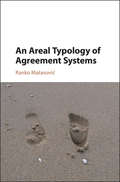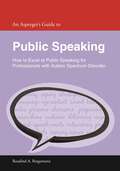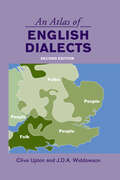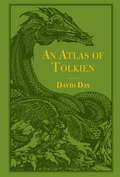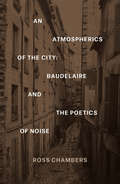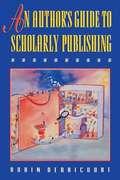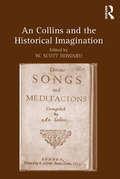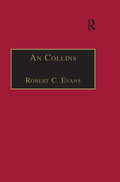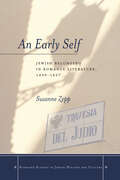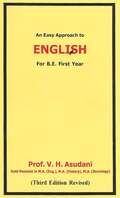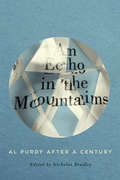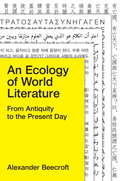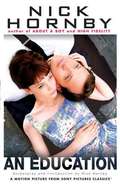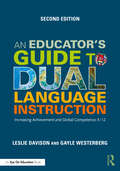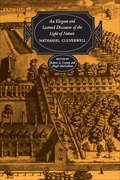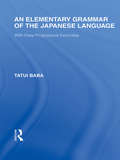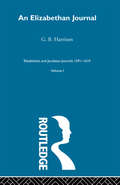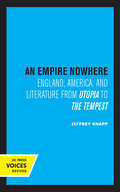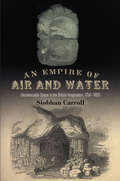- Table View
- List View
An Areal Typology of Agreement Systems
by Ranko MatasovićSurveying over 300 languages, this typological study presents new theoretical insights into the nature of agreement, as well as empirical findings about the distribution of agreement patterns in the world's languages. <P><P>Focussing primarily on agreement in gender, number and person, but with reference to agreement in other smaller categories, Ranko Matasović aims to discover which patterns of agreement are widespread and common in languages, and which are rather limited in their distribution. He sheds new light on a range of important theoretical questions such as what agreement actually is, what areal, typological and genetic patterns exist across agreement systems, and what problems in the analysis of agreement remain unresolved.<P> Describes in detail the areal distribution of several patterns of agreement.<P> A useful resource for linguists working on areal typology and seeking evidence for prehistoric language contacts and genetic relationships.<P> All theoretical concepts are defined and clearly explained.
An Asperger's Guide to Public Speaking: How to Excel at Public Speaking for Professionals with Autism Spectrum Disorder
by Rosalind A. BergemannThis practical guide to effective public speaking for professionals with Asperger Syndrome (Autism Spectrum Disorder) provides tailored advice on using your Asperger strengths to your advantage and overcoming areas of challenge to find your public speaking voice. Written by a business leader with Asperger Syndrome, it includes guidance and hands-on tools for preparation, research and delivery of successful speeches and presentations. It addresses all the key areas that can cause particular difficulty for people with Asperger Syndrome such as coping with anxiety, interpreting the facial expressions of your audience, awareness of your own body language as projected to others, sensory overload issues caused by the speaking environment, and surviving post-speech networking and social events. Whether giving a presentation at a meeting, hosting a corporate event, or delivering an autism awareness speech, this book provides all the guidance that professionals with Asperger Syndrome need to master public speaking.
An Atlas of Endangered Alphabets: Writing Systems on the Verge of Vanishing
by Tim BrookesA global exploration of the many writing systems that are on the verge of vanishing, and the stories and cultures they carry with them.If something is important, we write it down. Yet 85% of the world's writing systems are on the verge of vanishing - not granted official status, not taught in schools, discouraged and dismissed.When a culture is forced to abandon its traditional script, everything it has written for hundreds of years - sacred texts, poems, personal correspondence, legal documents, the collective experience, wisdom and identity of a people - is lost.This Atlas is about those writing systems, and the people who are trying to save them. From the ancient holy alphabets of the Middle East, now used only by tiny sects, to newly created African alphabets designed to keep cultural traditions alive in the twenty-first century: from a Sudanese script based on the ownership marks traditionally branded into camels, to a secret system used in one corner of China exclusively by women to record the songs and stories of their inner selves: this unique book profiles dozens of scripts and the cultures they encapsulate, offering glimpses of worlds unknown to us - and ways of saving them from vanishing entirely.
An Atlas of Endangered Alphabets: Writing Systems on the Verge of Vanishing
by Tim BrookesA global exploration of the many writing systems that are on the verge of vanishing, and the stories and cultures they carry with them.If something is important, we write it down. Yet 85% of the world's writing systems are on the verge of vanishing - not granted official status, not taught in schools, discouraged and dismissed.When a culture is forced to abandon its traditional script, everything it has written for hundreds of years - sacred texts, poems, personal correspondence, legal documents, the collective experience, wisdom and identity of a people - is lost.This Atlas is about those writing systems, and the people who are trying to save them. From the ancient holy alphabets of the Middle East, now used only by tiny sects, to newly created African alphabets designed to keep cultural traditions alive in the twenty-first century: from a Sudanese script based on the ownership marks traditionally branded into camels, to a secret system used in one corner of China exclusively by women to record the songs and stories of their inner selves: this unique book profiles dozens of scripts and the cultures they encapsulate, offering glimpses of worlds unknown to us - and ways of saving them from vanishing entirely.
An Atlas of English Dialects: Region and Dialect (Routledge Library Editions: The English Language Ser.)
by Clive Upton J.D.A WiddowsonDo you call it April Fools’ Day, April Noddy Day or April Gowkin’ Day? Is the season before winter the Autumn, the Fall or the Backend? When you’re out of breath, do you pant, puff, pank, tift or thock? The words we use (and the sounds we make when we use them) are more often than not a product of where we live, and An Atlas of English Dialects shows the reader where certain words, sounds and phrases originate from and why usage varies from region to region. The Atlas includes: ninety maps showing the regions in which particular words, phrases and pronunciations are used detailed commentaries explaining points of linguistic, historical and cultural interest explanations of linguistic terms, a bibliography for further reading and a full index. Based on the Survey of English Dialects – the most extensive record of English regional speech – the Atlas is a fascinating and informative guide to the diversity of the English Language in England.
An Atlas of Tolkien: An Illustrated Exploration of Tolkien's World (Tolkien)
by David DayThis lavish, colour atlas is a complete guide to the weird and wonderful geography of Tolkien's world. Packed with full page maps and illustrations of events in the annals of Middle-earth, it is the perfect companion to the bestselling A Dictionary of Tolkien. This book is unofficial and is not authorised by the Tolkien Estate or HarperCollins Publishers.
An Atmospherics of the City: Baudelaire and the Poetics of Noise (Verbal Arts: Studies in Poetics)
by Ross ChambersWhat happens to poetic beauty when history turns the poet from one who contemplates natural beauty and the sublime to one who attempts to reconcile the practice of art with the hustle and noise of the city?An Atmospherics of the City traces Charles Baudelaire’s evolution from a writer who practices a form of fetishizing aesthetics in which poetry works to beautify the ordinary to one who perceives background noise and disorder—the city’s version of a transcendent atmosphere—as evidence of the malign work of a transcendent god of time, history, and ultimate destruction.Analyzing this shift, particularly as evidenced in Tableaux parisiens and Le Spleen de Paris, Ross Chambers shows how Baudelaire’s disenchantment with the politics of his day and the coincident rise of overpopulation, poverty, and Haussmann’s modernization of Paris influenced the poet’s work to conceive a poetry of allegory, one with the power to alert and disalienate its otherwise inattentive reader whose senses have long been dulled by the din of his environment.Providing a completely new and original understanding of both Baudelaire’s ethics and his aesthetics, Chambers reveals how the shift from themes of the supernatural in Baudelaire to ones of alienation allowed a new way for him to articulate and for his fellow Parisians to comprehend the rapidly changing conditions of the city and, in the process, to invent a “modern beauty” from the realm of suffering and the abject as they embodied forms of urban experience.
An Author's Guide to Scholarly Publishing
by Robin DerricourtDirectly specifically to academic authors, this realistic handbook is a guide to publishing success for both beginning and seasoned scholars.
An Collins and the Historical Imagination
by W. Scott HowardThe first edited collection of scholarly essays to focus exclusively on An Collins, this volume examines the significance of an important religious and political poet from seventeenth-century England. The book celebrates Collins’s writing within her own time and ours through a comprehensive assessment of her poetics, literary, religious and political contexts, critical reception, and scholarly tradition. An Collins and the Historical Imagination engages with the complete arc of research and interpretation concerning Collins’s poetry from 1653 to the present. The volume defines the center and circumference of Collins scholarship for twenty-first century readers. The book’s thematically linked chapters and appendices provide a multifaceted investigation of An Collins’s writing, religious and political milieu, and literary legacy within her time and ours.
An Collins: Printed Writings 1641–1700: Series II, Part Two, Volume 1 (The Early Modern Englishwoman: A Facsimile Library of Essential Works & Printed Writings, 1641-1700: Series II, Part Two #Pt. 2)
by Robert C. EvansAn Collins' Divine Songs and Meditacions were first printed in a small octavo volume in London in 1653. The only extant copy is presently held at The Huntington Library and it is, therefore, this copy that is reproduced in this facsimile edition. It is an important text because it is one of the earliest volumes of collected poems by an English woman in the seventeenth century. The poems are especially intriguing because of the glimpses they provide into the life and mind of a woman writer during this period and because of the social, political, historical and religious contexts in which they are embedded. The precise identity of An Collins' remains a mystery, and scholars have had to rely on the Divine Songs and Meditacions for most of their understanding of its author, often drawing very different conclusions about her religious, social and political beliefs. To date critics have focused on the biographical and historical interest of the poems, but as Robert Evans highlights in his Introductory Note to the volume, these works also exhibit a rhetorical power and skill that merits further attention.
An Early Self: Jewish Belonging in Romance Literature, 1499-1627
by Susanne Zepp translated by Insa KummerWhat role has Jewish intellectual culture played in the development of modern Romance literature? Susanne Zepp seeks to answer this question through an examination of five influential early modern texts written between 1499 and 1627: Fernando de Rojas's La Celestina, Leone Ebreo's Dialoghi d'amore, the anonymous tale Lazarillo de Tormes (the first picaresque novel), Montaigne's Essais, and the poetical renditions of the Bible by João Pinto Delgado. Forced to straddle two cultures and religions, these Iberian conversos (Jews who converted to Catholicism) prefigured the subjectivity which would come to characterize modernity. As "New Christians" in an intolerant world, these thinkers worked within the tensions of their historical context to question norms and dogmas. In the past, scholars have focused on the Jewish origins of such major figures in literature and philosophy. Through close readings of these texts, Zepp moves the debate away from the narrow question of the authors' origins to focus on the innovative ways these authors subverted and transcended traditional genres. She interprets the changes that took place in various literary genres and works of the period within the broader historical context of the sixteenth and seventeenth centuries, demonstrating the extent to which the development of early modern subjective consciousness and its expression in literary works can be explained in part as a universalization of originally Jewish experiences.
An Easy Approach to English For B.E. First Year
by Prof. V. H. AsudaniThis book “An Easy Approach to English” aims at presenting various topics in an easy and comprehensive manner for the students. For the convenience, the book has been divided into seven sections. The first section deals with prose, the second with precis writing, the third with report writing, the fourth with letter writing, the fifth with essay writing, the sixth with public speaking and the seventh is devoted to the consideration of various topics of English Grammar. Not only the students of B. E. first year who prepare for English but all those who are desirous of improving their understanding of English Grammar and enhance their skills of English comprehension would find this book extremely useful. Suggestions from the readers are welcome as they will enable us to bring about necessary improvements in the forthcoming edition of this book.
An Echo in the Mountains: Al Purdy after a Century
by Nicholas BradleyFrom the 1960s until his death in 2000, Al Purdy was one of the most prominent writers in Canada, famous for his frank language and his boisterous personality. He travelled the country and wrote about its people and places from Newfoundland to Vancouver Island. A central figure in the CanLit explosion of the sixties and seventies, Purdy has been called the best, the most, and the last Canadian poet. But Purdy's Canada no longer exists. A changing country and shifting attitudes toward Canadian literature demand new perspectives on Purdy's impact and accomplishments. An Echo in the Mountains reassesses Purdy's works, the shape of his career, and his literary legacy, grappling with the question of how to read Purdy today, a century after his birth and in a new era of Canadian literature. Contributors to the volume examine Purdy's critical reception, explore little-known documents and textual problems, and analyze his representations of Canadian history and Indigenous peoples and cultures. They show that much remains to be discovered and understood about the poet and his immense body of work.The first sustained examination of Al Purdy's works in over a decade, An Echo in the Mountains showcases the critical challenges and rewards of rereading an iconic and influential Canadian writer.
An Ecology of World Literature
by Alexander BeecroftWhat constitutes a nation's literature? How do literatures of different countries interact with one another? In this groundbreaking study, Alexander Beecroft develops a new way of thinking about world literature. Drawing on a series of examples and case studies, the book ranges from ancient epic to the contemporary fiction of Roberto Bolaño and Amitav Ghosh. Moving across literary ecologies of varying sizes, from small societies to the planet as a whole, the environments in which literary texts are produced and circulated, An Ecology of World Literature places in dialogue scholarly perspectives on ancient and modern, western and non-western texts, navigating literary study into new and uncharted territory.From the Trade Paperback edition.
An Edible Alphabet
by Bonnie ChristensenEach page shows a letter of the alphabet in capital and small, a picture with the name of a plant, and pictures showing how the plant is used. A multi-cultural, multi-generational cast of characters makes this an unusual alphabet.
An Education
by Nick HornbyFrom the New York Times bestselling author—the shooting script to his award-winning film, with an original Introduction and vivid stills from the movie. Jenny is a 16-year-old girl stifled by the tedium of adolescence; she can’t wait for her sophisticated adult life to begin. One rainy day her suburban existence is upended by the arrival of David, a much older suitor who introduces her to a glittering new world of concerts, art, smoky bars, urban nightlife, and his glamorous friends, replacing her traditional education with his own version. It could be her awakening—or her undoing. This edition of Hornby’s adapted screenplay, which includes stills from the film, is a perfect accompaniment to the highly anticipated movie, which stars Carey Mulligan as Jenny, Peter Sarsgaard, Emma Thompson, Dominic Cooper, and Alfred Molina. It is a must-have for fans of Hornby’s novels, featuring his signature pitch-perfect dialogue, mordant wit, and the resonant humanity of his writing. Watch a Video .
An Educator's Guide to Dual Language Instruction: Increasing Achievement and Global Competence, K–12
by Gayle Westerberg Leslie DavisonThis user-friendly book is a key resource for teachers and administrators to ensure their school’s success in implementing and maintaining a dual language program. Authors Gayle Westerberg and Leslie Davison share their own experiences leading a dual language school, the obstacles they overcame, and the best practices they learned along the way. The book is filled with step-by-step instructions and strategies you can try immediately, as well as inspirational stories from educators in urban and rural dual language programs across the country. Topics include: Choosing a model for your dual language program and involving all stakeholders in the transition process; Marketing your program effectively to recruit students and staff, including international teachers; Implementing a standards-based instructional framework focused on direct vocabulary instruction, extensive reading, and using language in context; Setting proficiency targets and using internal and external assessments to track students’ progress; Incorporating technology for a more interactive and engaging language-learning experience. You’ll also learn how to effectively transition your program through different grade levels and build a collaborative school culture for a strong, long-lasting K–12 dual language program. Additional resources are available on the authors’ website, www.duallanguageinstruction.com.
An Educator's Guide to Dual Language Instruction: Increasing Achievement and Global Competence, K–12
by Gayle Westerberg Leslie DavisonComprehensively updated, the second edition is a user- friendly resource for teachers and administrators to ensure their school’s success in implementing and maintaining a dual language program. The book is filled with step-by-step instructions and strategies you can try immediately. The second edition includes key updates on technology, digital resources, and current demographics, standards, and data. Educators will learn how to choose a model for their dual language program involving all stakeholders in the transition process, set proficiency targets and use assessments to track progress, and much more.
An Effort Based Approach to Consonant Lenition (Outstanding Dissertations in Linguistics)
by Robert KirchnerThe first serious typological survey of the lenition process in modern phonological literature.
An Elegant and Learned Discourse of the Light of Nature
by Robert Greene Hugh Maccallum Nathaniel CulverwellComposed in a period of religious and political upheaval, Culverwell's Discourse of the Light of Nature is an imaginative statement of the teachings of Christian humanism concerning the nature and limits of human reason and the related concepts of natural and divine law. The lengthy introduction to this new critical edition throws light on the evolution of English rationalism in the seventeenth century, and the annotation establishes for the first time the full range of Culverwell's sources – classical, medieval, and Renaissance – and enables the reader to appreciate his manner of citing authority and handling illustration. (Department of English Studies and Texts 17)
An Elementary Grammar of Old Icelandic (Routledge Library Editions: Linguistics)
by Helen MacMillan BuckhurstThe first available Elementary Grammar of Old Icelandic in the English language, this book is primarily intended for the beginner. To this end, the greater part of the space is devoted to a detailed treatment of the inflexions and of such points of syntax as are likely to cause difficulties.
An Elementary Grammar of the Japanese Language: With Easy Progressive Exercises (Routledge Library Editions: Japan)
by Tatui BabaWhen originally published in 1873 one of the aims was to protest against an idea that the Japanese language was very imperfect, and therefore it should be exterminated! The second was to give a general idea of the Japanese language as it is spoken.
An Elizabethan Journal V1
by G.B. HarrisonFirst Published in 1999. Routledge is an imprint of Taylor & Francis, an informa company.
An Empire Nowhere: England, America, and Literature from Utopia to The Tempest (The New Historicism: Studies in Cultural Poetics #16)
by Jeffrey KnappWhat caused England's literary renaissance? One answer has been such unprecedented developments as the European discovery of America. Yet England in the sixteenth century was far from an expanding nation. Not only did the Tudors lose England's sole remaining possessions on the Continent and, thanks to the Reformation, grow spiritually divided from the Continent as well, but every one of their attempts to colonize the New World actually failed. Jeffrey Knapp accounts for this strange combination of literary expansion and national isolation by showing how the English made a virtue of their increasing insularity. Ranging across a wide array of literary and extraliterary sources, Knapp argues that English poets rejected the worldly acquisitiveness of an empire like Spain's and took pride in England's material limitations as a sign of its spiritual strength. In the imaginary worlds of such fictions as Utopia, The Faerie Queene, and The Tempest, they sought a grander empire, founded on the "otherworldly" virtues of both England and poetry itself. This title is part of UC Press's Voices Revived program, which commemorates University of California Press's mission to seek out and cultivate the brightest minds and give them voice, reach, and impact. Drawing on a backlist dating to 1893, Voices Revived makes high-quality, peer-reviewed scholarship accessible once again using print-on-demand technology. This title was originally published in 1992.
An Empire of Air and Water: Uncolonizable Space in the British Imagination, 1750-1850
by Siobhan CarrollPlanetary spaces such as the poles, the oceans, the atmosphere, and subterranean regions captured the British imperial imagination. Intangible, inhospitable, or inaccessible, these blank spaces—what Siobhan Carroll calls "atopias"—existed beyond the boundaries of known and inhabited places. The eighteenth century conceived of these geographic outliers as the natural limits of imperial expansion, but scientific and naval advances in the nineteenth century created new possibilities to know and control them. This development preoccupied British authors, who were accustomed to seeing atopic regions as otherworldly marvels in fantastical tales. Spaces that an empire could not colonize were spaces that literature might claim, as literary representations of atopias came to reflect their authors' attitudes toward the growth of the British Empire as well as the part they saw literature playing in that expansion.Siobhan Carroll interrogates the role these blank spaces played in the construction of British identity during an era of unsettling global circulations. Examining the poetry of Samuel T. Coleridge and George Gordon Byron and the prose of Sophia Lee, Mary Shelley, and Charles Dickens, as well as newspaper accounts and voyage narratives, she traces the ways Romantic and Victorian writers reconceptualized atopias as threatening or, at times, vulnerable. These textual explorations of the earth's highest reaches and secret depths shed light on persistent facets of the British global and environmental imagination that linger in the twenty-first century.
